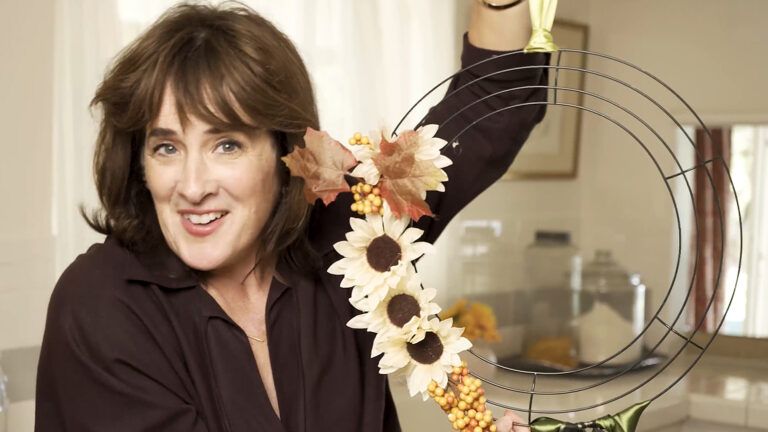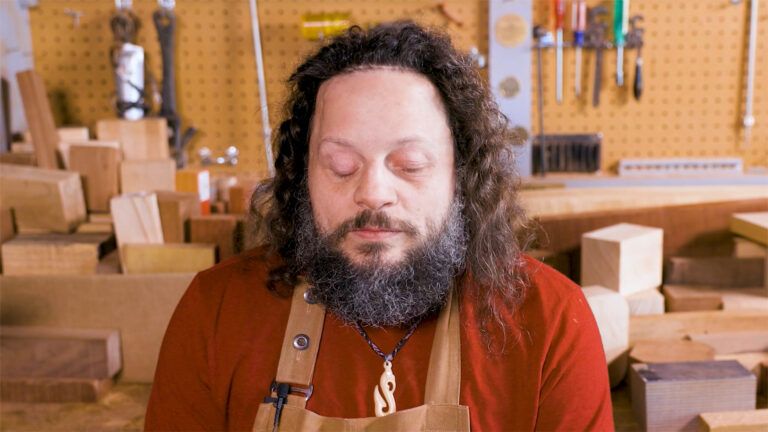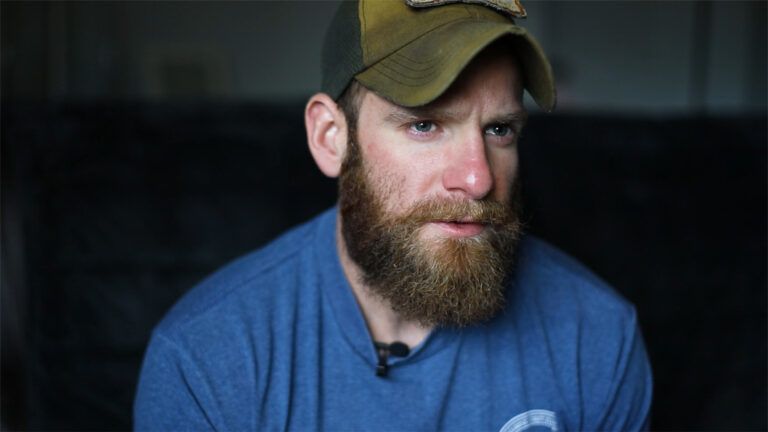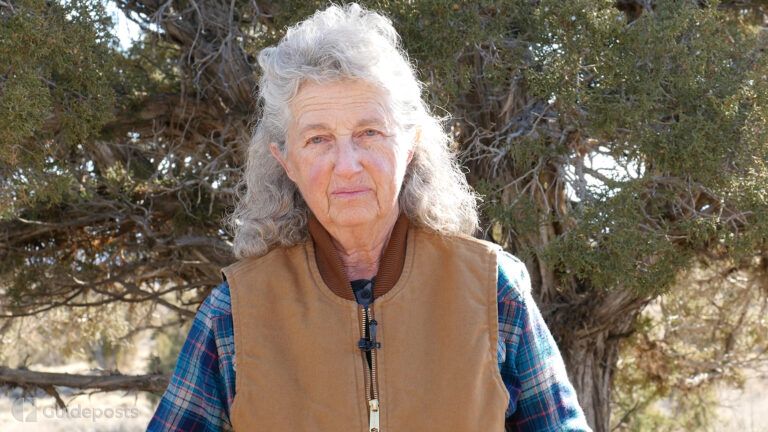
Quick n’ Crafty: How To Make A Pine Needle Basket
Watch as Susan Topham takes you through each step of a creative and relaxing DIY project.
View Transcript
Guideposts Video: Inspiring True Stories
Hello, I’m Susan Topham. And I’m going to show you how to make a simple pine needle basket, such as this one here.
[MUSIC PLAYING]
To start with, I have the materials here needed to make a pine needle basket. First off, there’s artificial sinew, and then of course, pine needles. And you can see here an individual pine needle. These are about eight inches long.
Pliers, scissors, tapestry needles. And this here is a one-inch-long segment, a 1 and 1/2 inch-long segment of a drinking straw. And paper towels and a one gallon Ziploc bag. These are all the materials needed to make a pine needle basket.
The first thing that you have to do is a normal pine needle is easily breakable. It just shatters. So in order to have the pine needles flexible enough to bend to make a round or an oval basket, you need to soak them in water overnight. So here I have a container full of water. And I just put the pine needles in there overnight.
And now they’re much more flexible. I can bend them a long ways before they break. All right, you’ve soaked your pine needles overnight. But they have these caps on the end. So you need to cut those off.
You take your scissors, you cut them off. And just keep doing that until you have a nice supply of them. Now that you have your pine needles ready, you need to get your sinew ready. So here we have a spool of sinew.
You need to spool out two arm widths worth. As far apart as you can spread your arms, and grab it, and do it a second time. That’s a good length. Then go ahead and cut that off at that length.
All right, now you have this nice long spool of sinew. But the sinew comes in too wide of a width for what we are doing today. You need a split in half or in thirds. About half of it is on one side and half is on the other, you just split it.
One goes one way and one goes the other. Get out your tapestry needle and thread it onto the sinew. Now we got that set. You take the drinking straw that you had, and pine needles, and you fill the straw up full of pine needles.
You want it to be full but not too tight, so you can still slide the straw down the pine needles. All right. Got them all started. Now we want to get the end of the pine needles all even. Just tap them back until they’re all starting in about the same spot.
So now they’re very even at the end. And take the end of your artificial sinew and go around the end of the pine needles. Oh, anywhere from a quarter to a half an inch from the end. Probably about 1/4 of an inch from the end. And tie a square knot.
Now, you want to tie this as tight as you can without breaking the pine needles or the artificial sinew. And if the end of your pine needles aren’t quite square– I have one sticking out here– you can take out your scissors and cut the ends off. Now it’s nice and square.
All right, the short end of the sinew here, just pull it up against the pine needles here. You can hold it over with your thumb, nice and flat. And with the other hand, start wrapping the artificial sinew around the pine needles. And at this point, you’re just covering up the pine needles. So you won’t see any pine needles through this.
And you want to do this for– with the size basket we’re making today, you’ll want to go down about an inch, inch and 1/2. Now that you have this wrapped, you still have the end of the artificial sinew hanging out here. You can just cut that off with your scissors, it’s not needed. OK.
So now you’ll want to bend over the pine needles. Just bend it back around on itself. Now, find your needle, wherever it’s located on your artificial sinew. This is going to be your first stitch.
It can be pretty tight or pretty hard getting the needle to go through here. So if you have to, you can use pliers. This first one went easy enough. But just pull it tight, then go down about 1/8 to 1/4 of an inch and do your next stitch. Shove it through and pull it tight as well.
Just keep going. The spacing on your stitches isn’t as important as just making them the same distance apart. You want them to be even compared to each other. It makes for a nicer looking basket.
And then if you have a hard time getting the needle through, you can just grab the needle in the center with your pliers. And use your pliers to push it through, then pull it out the other side. Just make sure that you don’t grab the eye of the needle because you can break the needle. You can pull it tight.
Whenever you need to, you move the straw out of your way. I’m running out of pine needles. So just grab more pine needles and try to add them in the center of what you have there. You separate them a little bit, add them in the center.
The purpose of your straw here is to keep it so you’re constantly having the same amount of pine needles. You don’t all of a sudden have a bunch and then run out and have none. It keeps your pine needles grouped together and it makes it so you’re consistently adding the same amount of pine needles.
And then we get to the end here and just bend over your pine needles again. Just bend them over. Let’s see. I left too much here. If it’s too long, just cut it down shorter. That’s better.
It’s generally best to get your stitch through and started, but don’t pull it tight until with the other hand you can bend the pine needles over. Then pull it as tight as you can without breaking anything. The pine needles are wet right now. And when they dry out, they’re going to shrink.
If you don’t pull your stitches tight at this stage, then when your basket dries, it will be very loose. So you want to keep everything tight. All right, this is your basket after about 15 minutes. You’re starting in on about your second coil.
And you just keep going like this. This is how we’re going to do the base. Just keep doing the same thing for however long it takes to get the size base that you want. As you’re making you an oval basket, occasionally you’ll need to add stitches on the end here.
You just add them in between the stitches that you have. Because if the stitches get more than about 3/8 of an inch apart, your basket strength starts to weaken. So you want to keep your stitches close together. And whenever you need to add stitches, just add them consistently around the end you need to. Just do it all at once on a row and do it on the other end at the same time and keep working on your basket.
OK, at this stage in your basket, as you make your basket bigger, the end needs more stitches. Because here on the side, they’re about 1/8 of an inch apart. But here on the end, you can see that the stitches are farther apart.
So what you’re going to do is you’re just going to add a stitch between each one on the end here. You can see the advantage of having longer pine needles. You don’t have to add them as often. With shorter pine needles, you’re constantly adding more material to keep your basket going.
And as you can see at this point, my basket is extremely twisted. You can just pull the twist out of it. And if it’s too much of a problem, before you start doing the sides, you’ll want to keep your basket under a heavy object overnight, some sort of a container that has a lot of weight.
I do a milk jug or anything that has a lot of weight. Just set it on top of your basket and it’ll take the twist out of it before you go up the sides. All right. We’ve made it to the far end. So you’ll want to start adding a stitch in between every stitch that you already have there in order to match what you did on the far end.
Whatever you do on these baskets, you want to be consistent so that the whole basket looks the same. I’ve progressed farther on the basket. And even though my stitches have been even, and I’ve been adding pine needles evenly, I don’t know if you can see here, but there’s a dip forming in my basket here.
So in order to correct that, you can just add pine needles underneath what you have there to just kind of bulk that part up since it’s getting to be a little bit narrower than the rest of the basket. Just add them underneath. You kind of have to hold them in there a bit, unless you shove them in there. And then continue on with your stitches.
So now you can see it’s nice and even. And I’m going to cut the excess of those off where they went past where my basket was still level. So now that I have it all level, I’ll just continue on like I had been.
All right, we’ve gotten to the point where you’re just about out of sinew. It’s getting hard to make a stitch. You don’t have enough sinew left. So pull your last stitch tight. And go ahead and take the needle off. And this is the sinew, the other half of the sinew from when we started.
However you had it, unroll it. Now tie a square knot as close as you can to where the sinew came out from your last stitch. Pull it tight. Now you’ll want to slide it back out a little bit. You can just pull on it, it’ll slide back out about a quarter of an inch.
And then it wouldn’t hurt to just take another loop and pull that tight as well. And maybe even another one after that because the artificial sinew kind of has some wax on it and it’s slippery. So you don’t want your knot to come undone there. Then go ahead and get your needle on the end of the sinew.
Then take your next stitch. Pull that through and pull it tight just like you have been. Now, your knot, you’re trying to get it on top. It would end up right here on top of the pine needles. Part it tight enough so it does that. And hopefully, that will be as tight as you’ve normally been pulling things. Get it that tight.
And go ahead and get your next stitch started. You’ll go ahead and pull the sinew most of the way through. But not all the way. All right, take both ends, the ends that you finished and the other ends, and just pull them tight against the top of your pine needles. Hold it there with your hand and pull your stitch tight.
You’re wanting everything besides where you’re stitching, whatever is going to be left, you want it to be up here on top. So that when you come around with your next coil, it will cover this up and no one will see it.
Your basket is going to be a several day project. So when you’re not working on your basket, you need to keep the pine needles wet. The best way to do this is to just take a paper towel, get it damp under a faucet. So that you have a paper towel that’s damp.
Take your pine needles and wrap them up in it. So they’ll stay wet but not so wet that they mold. Get a gallon Ziploc bag, or a two gallon, whatever works. Put your pine needles in there. And then also wrap up the sinew nicely on your basket, however that is. Any way that it won’t get knots in it. And then stick that in your Ziploc bag as well.
You don’t want it to get as damp as the pine needles because it will mold easier. But you’re wanting to keep the pine needles here that you still have to bend, you want to keep them wet. So if you wrap sinew around them and tighten them when they’re dry, they’ll break. So you want to keep those moist as well.
So you can just zip that up and put it in your refrigerator until you’re done with your basket. The only thing is, you don’t want to put your basket in there for more than a couple of weeks because even under these circumstances, it will mold.
So if you decide after a week or two that you will have time to work on your basket for a while set it out and let it dry out. And then when you decide to come back to your basket, dampen up the pine needles that still need to be bent, and put it in the fridge for a day or two.
The basket has progressed farther along. This is actually about three hours of work for me. I am a very slow basket maker. Other people can probably do this a lot faster. But I’m making a small basket here and I’m ready to go up. Now that I have the base, I’m going to start up the edges.
What you do is, with your pine needles, you pull them up a bit. And now you’ve been going directly through with all of your stitches, you’ve just been going straight through. Now you’re going to go through at an angle.
So you’re going to pull the pine needles up. You’re going to go through where the pine needles would have been. And when you come up the top side, you’re going to basically be coming out the bottom of your previous coil.
You’re going to pull that tight. And you’re going to do it again. On this one, the way I’m doing this basket, this coil is going to cover up about half of the previous coil. So you just keep going about half way through. And then when you come through on the top, it will be at the bottom of the coil.
Just keep pulling it tight. And make sure on each stitch that you go through it about the same spot and you have the pine needles at about the same level. You want to be consistent.
I have now made one coil around what will be the side of my basket. At this point, I’m going to teach you a new stitch, since that’s the kind of basket we’re doing. If you kept up, you could just finish the basket like this using this stitch. That’s perfectly fine. But for this basket, you’re going to learn a new stitch.
So what you do is you go make a stitch just like you have been, halfway through the sinew, halfway down the previous coil. Tighten that up. And then you go through the exact same hole that you just made a second time. Pull that stitch tight as well. And then move on to your next stitch.
With this stitch on the sides, your stitches will go up vertically. If you kept up just doing the running stitch like you have been doing, the sides would swirl up. But on this basket, we’re going to have the stitches going up straight.
Keep on going around like you have been, going through the same hole twice. And when you get to the next row, when you finally get back here to where you started doing two stitches in the same hole, you’re going to skip every other stitch.
So when you come around next time, you’re going to only go through the stitch that is to the left. So you’re going to go through this stitch here twice. You’re going through this stitch here twice. And this one. And then the one that I haven’t put in yet. And you’re going to do that on every row.
So you’re going to be going through each hole twice, but then the next coil that you do, you’re going to skip one of the stitches. So you’re not doing more stitches every row, every coil, next coil that you do. You’re going to be doing the same number of stitches.
And the stitch that you’re constantly going through is going to go straight up your basket. It’s not going to coil. And then I’ll have a stitch off to the side of each basket. Normally, you’d have the sides higher up than this. But for this instance, to show you how to finish one, I’m doing it at this low level.
All right, so I’ve been doing my stitches. When I came around the corner here, I stopped adding pine needles. I’m going to end the basket somewhere about here, about there, at the end of the straw here.
What I’m going to do now is I’m going to go ahead and take the straw off. It’s not helping me anymore now. So I’ll go ahead and continue with my stitches.
As I go farther along, I’m going to cut these pine needles off until I have only maybe three of them left. And my goal is to finish the top of the basket all level. To taper off the pine needles in such a way that the basket is level.
At this point, the pine needles still look like about the right amount to keep it level. So I’ll put in another stitch. All right, at this point, I need to remove some pine needles. So I’ll just get my scissors.
These ones on top look pretty nice the way they’re going. So I’m just going to pick them up and I’m going to use my scissors to cut off some of these that are down below. And this way, you also won’t see where the end. It’ll make the basket look nicer.
So I’ll do a stitch or two with the remaining pine needles that I have here. At this point, I’m getting even higher up, so I’m going to cut off this one on the side. It’s no longer needed. And one on the inside as well. So I’m down to three pine needles left. Hopefully the stitches will–
All right, on the next stitch, I’m going to end it. I’m only down to three pine needles and the top of my basket is pretty level. Anywhere where it’s kind of short, I kind of pull it up, and anywhere where it’s high, I’ll push it down to help make it level.
And if I can get it level, then I’m going to go ahead and end my basket. This here is going to be my last spot. I’m going to go ahead and before I do my last stitch, I’m going to cut one of these pine needles off the bottom. So I only two left, sticking out.
And I’m going to try to get them side by side so that they cover the top nicely. Ending the basket is, in my opinion, the hardest thing to do. Your goal is to do it so that a person can’t tell where you end it.
OK, you’re going to go through this time and instead of doing a running knit stitch, you’re going to pull this under your needle. So you’re going to be basically doing a half hitch, when you get done here. This is going to be a half hitch.
And at this point, you can go ahead and cut off the remaining pine needles. Now here, what you do, you have this stitch and your previous stitch here, you’re going to get your needle under all of them. Pull it through.
And then you’re going to have a loop. Run your needle through that. So you’re going to have a half hitch on the side here. And in all of this, you want to pull it really tight. OK. So you do that once and then do it a second time. As low down on the stitch in the side here as you can. This would still be your last stitch.
Pull this through, you have a loop, run your needle through it. That’s the second half hitch. All right, now that you have two half stitches, run your needle through from the inside of your basket to the outside.
You want to come through where your previous stitch was. I didn’t do a very good job there. You want to come out where your previous stitch is. Pull it out and then pull it tight. And it’s pulling your knot in here, and if you do it right, it’ll actually pull your knot under where no one can see it.
I pulled it a little bit, but you can still see it a little bit. It’s in the inside where it’s harder to see. All right. Now that you have it pulled tight, go ahead and get your scissors and cut off the end of your string. Now you can see the string sticking out a little bit.
It’s kind of hard to see, but you can use the end of your needle and kind of push it back in a little bit where it’s no longer visible. And there you have a finished basket where the top is level and you can not see where it was ended. Where I can show.
At this point, you are not finished with your basket. You can see you have the ends of pine needles sticking up. And the way you deal with these is wait for your basket to dry for a few days. And then once it’s dry, these will break right off, right under the stitches so you can’t even see where the end is.
Your basket will be nice and clean. People won’t even know that the pine needles have an end to them. Also, once you’re done with that, once you’ve broken all these ends off and your basket looks beautiful, then what you want to do is with the outside of your basket, you want to spray it with gloss enamel. Or if you want to, you can use just natural enamel.
And what that does is it gives it a really nice shine to your basket. And it protects your basket and makes it stronger. If you want to, you can also wait a while before you spray your basket and it’ll have a different color to it.
Here I have this basket. I made it and I used it for over a year before I sprayed it. And notice the color on that basket versus this basket here, which I made and then as soon as it dried, I sprayed it. So that’s a different effect that you can get.
Also, don’t spray the inside of your basket. That way people can still smell the pine needle smell. And it is wonderful. I also wanted to show you the two different kinds of stitches you can use going up the side of your basket.
This is the stitch that I taught you, where you’re going through the same hole twice, and then when you go up to the next coil, you use one of the stitches and go through it twice again. You can see the stitches, they’re going up vertically. And they have a– the second stitch is dropped off to the side on each row.
So that’s what that would look like on an actual taller basket. If you just went with the running stitch like you did on the bottom of the basket all the way up the basket, this is what it would look like. It would coil around. And I hope you enjoyed watching this video.
[MUSIC PLAYING]
Thank you for watching and happy basket making.












